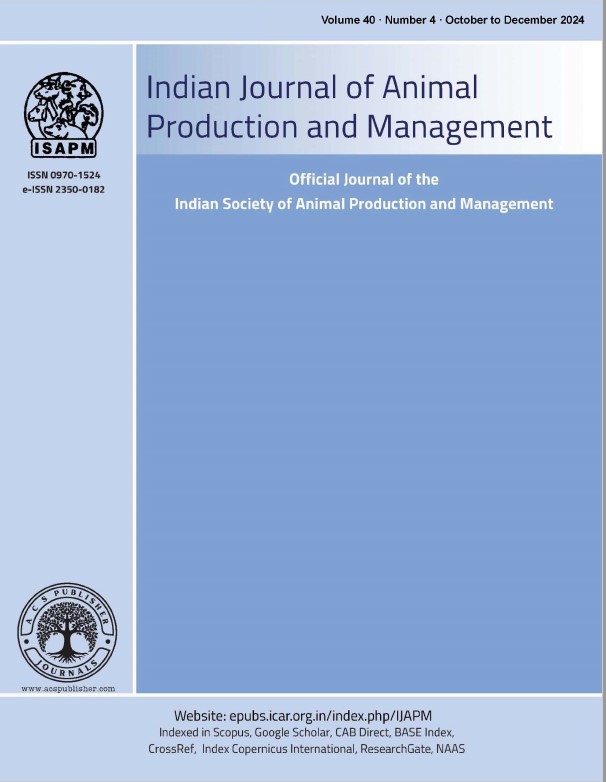Production performance and economics of Khaki Campbell ducks in the backyard system of rearing at the NICRA-adopted village in Darrang district of Assam
DOI:
https://doi.org/10.48165/ijapm.2024.40.4.2Keywords:
Khaki Campbell ducks, ackyard system, production performance, production, economic viability, AssamAbstract
This research paper evaluates the production performance and economic viability of Khaki Campbell ducks in backyard farming systems at NICRA-adopted flood-prone village in the Darrang district of Assam. The study investigates key productivity metrics such as egg production rates, growth performance, and survival rates, alongside economic factors including input costs, labor requirements, and market returns. The integration of Khaki Campbell ducks, renowned for their high egg yield and resilience, is explored as a sustainable agricultural practice that aligns with the objectives of the National Innovations in Climate Resilient Agriculture (NICRA) project. Findings indicate that Khaki Campbell ducks perform well in backyard systems, with notable egg production and robust growth. The mean body weight at 30 weeks was 1.82±8.4 kg, and the average age at first egg was 163±4.3 days. Throughout the study period, the mean egg production was 185.5±5.1, and the mean mortality rate was 12.5%. Economically, the practice is viable with a B:C ratio of 2.07, showing favorable returns compared to the investment and labor involved. The research highlights the potential for these ducks to enhance household income and nutritional security, contributing to greater agricultural resilience against climate variability. These insights provide valuable guidance for policymakers and rural development initiatives aiming to promote sustainable and climate-resilient agriculture in similar regions.
References
Bharali, D. and Borah, D. (2018). Performance of Khaki Campbell and local ducks in adopted villages for doubling farmers’ income at Udalguri district of Assam. The North East Veterinarian, 18(3): 35 - 37.
Gogoi, M. (2016). Livestock and Poultry Production in Assam. International Journal of Livestock Production, 7(6), 57-66.
Holderread, D. (2001). Storey's Guide to Raising Ducks: Breeds, Care, Health. Storey Publishing.
ICAR (2010). National Innovations in Climate Resilient Agriculture (NICRA) Project. Indian Council of Agricultural Research.
Jha, B.K. and Chakrabarti, A. (2017). Duck Farming: A potential source of livelihood in tribal village. Journal of Animal Health and Production, 5(2): 39 - 43.
Jones, E., Davies, H. and Patel, R. (2018). Growth Performance of Khaki Campbell Ducks in Different Agro-Climatic Zones: A Comparative Analysis. International Journal of Animal Science, 30(2), 87-101.
Roy, A., Roy, P.S., Datta, S., Haldar, A., Roy, U., Pathak, P.K., Patra, S., Taleb, A. and Maji, A. (2017). Supplementing rural livelihoods through backyard duckery farming in Murshidabad District of West Bengal, India. International Journal of Current Microbiology and Applied Sciences, 6(12): 3460 - 3466.
Singh, V.K., Chauhan, S.S., Ravikanth, K., Maini. S. and Rekhe, D.S. (2009). Effect of dietary supplementation of polyherbal liver stimulant on growth performance and nutrient utilization in broiler chicken. Veterinary World, 2(9): 350 - 352.
Smith, A., Johnson, B. and Brown, C. (2020). Production Performance of Khaki Campbell Ducks in Backyard Systems: A Comparative Study in Northern India. Journal of Poultry Science, 45(3), 211-225.
Snedecor, G.W. and Cochran, W.G. (1995). Statistical Methods. 8th edn. Oxford, IBH.

